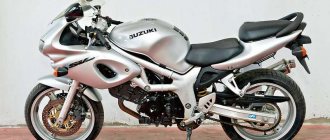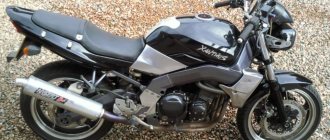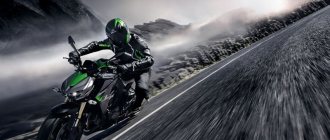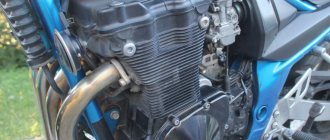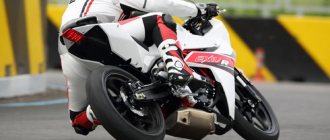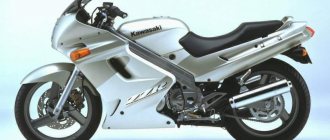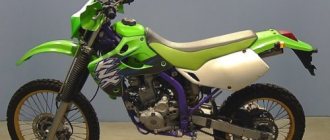- motorcycle model, Kawasaki brand,
The Kawasaki Z750 naked model was first introduced in 2003 at the Milan Motor Show, and the series began with 2004 models. The motorcycle was aimed at the market of Asian countries, North America and Europe. In Japan, this model is practically not represented.
The appearance of the Kawasaki Z750 was due to the need to create a naked bike that would replace the Kawasaki ZR-7 and would become a budget version of the flagship Z1000. This is how the Z750 was developed, which received the same engine as the Z1000, but in a reduced volume (the old air-oil engine from the ZR-7 did not meet either the environmental or modern technical requirements for motorcycles of this class). As a result, the engine was an in-line 4-cylinder liquid-cooled unit with a volume of 748 cm³, producing up to 110 hp. power and 75 Nm of torque.
In 2005, the Z750 line was replenished with a version with a front plastic fairing - the Kawasaki Z750S.
For 2007, the Z750 gets a makeover with updated styling, a new muffler, brakes and engine tuning. In addition to the regular version, versions with ABS are also offered.
In 2011, a new modification appeared - Kawasaki Z750R. It differs from the regular version in its overall dimensions, sports rear suspension, and 4-piston radial calipers at the front.
2013 was the last year of production of the Z750 model, after which it left the market, giving way to a new model - the Kawasaki Z800.
Assembly and release features
Externally, the Kawasaki Z750 model is difficult to distinguish from its older brother - the differences are visible only in the exhaust system and rims.
Assembly begins in the same year, and the very next year ( 2004 ) the motorcycle can be seen at authorized points of sale. Most of it is exported to Europe/America .
It also appeared in Japan, but did not arouse any interest.
The motorcycle has survived one generation change ; two modifications were created on its basis. The release lasted 9 years. In 2013, production was closed, and the model itself was gradually replaced by the Z800, introduced a year earlier. It is curious that the new product does not get a place on the conveyor. Her drawings are used for production facilities in Thailand.
Colors
Green (Candy Lime Green):
Black (Ebony):
Silver (Atomic Silver):
Specifications are based on the production model under standard operating conditions. They are intended to provide a general idea of the motorcycle and its capabilities only, however specifications of individual motorcycles sold may differ from those shown above. Kawasaki Heavy Industries Ltd. reserves the right to change specifications without prior notice. The equipment and specifications of the motorcycle presented in this manual may vary depending on the requirements of different regions of sale. Possible color options for the motorcycle may vary depending on the sales region.
Specifications
The motorcycle engine is structurally almost identical to the liter source from the ZR-7 model.
While developing the engine, the Japanese encountered a problem .
Although the motorcycle was a logical continuation of the ZR-7, it was impossible to use a slightly larger analogue of its engine, new environmental standards prevented it. Drawing from scratch is expensive.
Then production started out of the blue. They took the motor from the flagship and rebuilt it. The result was a smaller flagship that produced:
- working volume - 748 cm3;
- number of cylinders - 4, in-line arrangement;
- number of cycles - 4;
- number of valves - 16, 4 per cylinder;
- power - 109 (106) hp;
- torque - 75 (78) Nm;
- cooling - liquid;
- fuel supply - injector (injector + KDTV);
- ignition - digital;
- start - electric starter;
- tank volume - 19 (18.5) l.
The indicators of the second generation of the motorcycle, which entered the production line in 2007, are given in brackets.
Transmission and clutch
A classic chain drive and six-speed gearbox are more than enough for a naked bike of this level.
The motorcycle was equipped with a 6-speed gearbox.
Users noted that it did not work very clearly, this did not affect controllability, but the box required getting used to.
True, after several trips, further operation did not cause any problems. A significant part in this was played by the fact that the box itself is quite elastic, and the gear ratios are spaced far apart - there is no need to click often.
- The clutch is standard, multi-disc , in an oil bath. Power transmission is a cable .
- The main drive is chain .
Brakes
Before the generation change in 2007, the brakes had no special features. Hydraulic discs. In 2007, conventional discs were replaced by petal discs of our own design.
Front brakes – 2 discs.
Rear brakes – 1 disc.
Front brakes:
- number of disks - 2;
- disc diameter - 300 mm;
- support - 2-piston.
Rear brakes:
- number of disks - 1;
- disc diameter - 250 mm;
- support - 1-piston.
Another advantage of the update was the appearance of ABS on both disks. Some users noted that this is an optional feature, but the manufacturer noted that it is already installed at the factory.
Driving performance
The model is positioned as a sports motorcycle for fans of various riding styles.
The declared maximum speed is 230 km/h . However, according to users, such indicators are very overestimated. Comfortable cruiser - 140 km/h , then it just blows away.
It is worth noting that at the beginning of the production of the model, before the change of generations, the user could buy a version with a front fairing, for which such speeds were not something out of the realm of science fiction.
Acceleration to hundreds
Acceleration from zero to 100 km/h could be envied by other sports - in 3.2 seconds .
Fuel consumption
Fuel consumption, announced by company representatives, is 4.6 liters on a combined cycle. Users noted that with urban use you can see 7 out of 100.
What do the owners say?
Judging by the reviews from photos and videos, the car performs well on smooth roads. However, on problem sections of the route it is important to drive slowly. This applies to all sportbikes with classic suspension travel. The point is not only about the safety of the driver and others, but also about the fact that potholes quickly cause this and other representatives of the class to become unusable.
Most of the controversy concerns urban conditions. However, it is important to note that these, again, do not directly relate to the Kawasaki ZXR 750. We are talking about the sport class and whether it is advisable to buy such an option for an urban environment, no matter how much you like the characteristic design, fit and sounds.
According to the description of those who often travel around the city, the motorcycle often falls over in a smoothly flowing traffic jam. However, compared to sports tourists, the problem is not so acute. The view through the windshield suits everyone, as does driving on country roads.
Most owners are sympathetic to the technical characteristics of this sportbike, but warn that spare parts are not so easy to obtain, which makes maintenance difficult. Nowadays it’s no longer possible to get a new motorcycle, but the cost of a used one is low, and many people note this. About 190 thousand Russian rubles - that’s how much such a car costs.
Kawasaki ZXR 750 is a good bike for its era. Now the model is suitable for those who do not want to drive a super-powerful representative of the sports class. If average speeds suit you, then this option will please you on the race track. For those who need a regular bike to get around, neither this machine nor any other sports bike is suitable.
Dimensions and weight
The Kawasaki Z750 is a typical mid-weight naked bike (another name is streetfighter).
Due to the change of generation, the weight of the motorcycle has increased slightly:
The curb weight was 218 kg before the generation change and 226 kg after the change. The introduction of ABS increased the weight to 230 kg .
The version with a fairing, which was mentioned just above, weighed 222 kg .
The dimensions have also changed:
- became longer in length - from 2,080 to 2,085 mm ;
- thickened in width - from 780 to 805 mm ;
- the height also increased - from 1,055 to 1,100 (version with fairing 1,180 ) mm;
The saddle height has not changed - 815 mm .
The wheelbase has become longer - up to 1,440 mm , and the ground clearance is lower - up to 155 mm .
For whom is it intended?
As the manufacturers stated, the motorcycle is being exported, therefore, it should provide maximum comfort to the average resident of Europe, Russia, America, or rather to a biker of average height.
The seat on the bike is narrower, stiffer and shorter compared to its predecessor.
It is curious that if the buyer found the saddle too high for him, he was offered a version with a fairing, where it was 10 mm lower. Tall bikers could be offered one of the modifications, where the saddle was higher - 825 mm .
Modifications
2004 Kawasaki Z750.
2005 Kawasaki Z750S with front fairing.
As already mentioned, the motorcycle was offered in three modifications.
- Kawasaki Z750 - basic equipment. Naked. Launched in 2004 , received ABS and other updates in 2007 , closed in 2013.
- Kawasaki Z750S - born in 2005 . However, it is not in great demand and during the 2007 it is considered unprofitable, after which it leaves the assembly line.
- Kawasaki Z750R - appears in 2011 . The version receives a sports suspension, the front brake calipers become radial, and a 4-piston . Interestingly, the year the production of the model ended is not clear. Either together with the basic one, or a year later.
History of changes
The model has undergone a number of changes over its long journey. Here are the main stages in the development of this motorcycle:
- 2004 – start of production;
- 2005 – the Z750S version was released;
- 2006 – major restyling;
- 2011 – version Z750R appears;
- 2012 – end of release.
The motorcycle has left a good impression on many experienced bikers over the years. Some consider the model almost sporty. The developments embodied in the Z750, of course, were reflected in the next – 800th – model.
and competitors
The competitors were not asleep, and even though Kawasaki and its model immediately grabbed the lion’s share of sales, they tried to squeeze it out.
Yamaxa FZ6.
Suzuki GSR750.
Honda Hornet CB 600.
FZ6
The Yamaha developers did this best. Their model Yamaxa FZ6, and then FZ8 (father 6 and 8, respectively) actively stepped on its heels, had modifications naked and with a fairing, and ultimately won the fight - Fazer 8 forced Kawasaki to think about a more powerful model.
GSR750
Suzuki did not want to stand aside - its GSR750 model also had two design options, and the version with a fairing even had carbon parts, but did not gain an advantage. Neither Yamaxa nor Kawasaki took the carbon fairing seriously.
Hornet (CB 600)
Honda at that time did not have a suitable motorcycle, as it was actively promoting the Hornet model (CB 600). I put her out. The second and third generations could match the capabilities of the Z750, but did not make any impact on the market.
Hornet was bought only by fans of the brand, combi-breaks and safety.
Appearance
The original exterior combines three colors: green, white and blue. The motorcycle is painted with several diagonal lines, as is usually done with sports models. This is perhaps the most aesthetic option for combining three or more colors in the color of a sportbike.
The design is ordinary, as are the dimensions. The windshield is low, but it is sufficient at high speeds when the rider rests on the tank. In other cases this is not required. Alloy wheels are no different from those on most old and current sportbikes. There are few chrome elements on the outside. First of all, the exhaust pipe.
Features of Kawasaki Z750
Essentially, the 750 is a “discounted” version of the liter Z100.
The owners considered unusual details
- Vibrations . Above 6,000 rpm, there is a slight vibration on the footpegs and saddle. It can be solved either by decreasing or increasing to 7k and higher.
- Possibility of wobbling when turning under the knee at high speed.
- Power valve in the exhaust bank . It is heavy, but if you change it, the traction at low speeds drops.
Flaws
According to users, the driver's saddle allows you to travel 80–100 kilometers tolerably.
Among the disadvantages, users note:
- The gearbox does not create any problems, but you still have to get used to it .
- The saddle is not very comfortable for long distance riding . The part for the second number is also quite tough;
- Fuel gauge on the dashboard. When parked lies shamelessly. It only shows normally when in motion. If the reserve inclusion limit is reached, information about this closes the odometer.
The instrumentation itself is of a mixed type - a dial tachometer and a digital speedometer display.
Most users note that ABS is needed, but there are no obvious complaints about the brakes.
and dignity
- Power - for city driving 4-5 kW is enough.
- Controllability.
- Heavy weight.
- Good weight distribution - difficult to spread out.
Many people admit that despite the heavy weight - it slips in traffic jams like clockwork - maneuverability is achieved through a short wheelbase.
Comfort
The car is easy to drive, although a beginner would be better off with a weaker sportbike (or the weakest road motorcycle, if a person is basically inexperienced in riding bikes). As with other sports variants, it is more convenient to drive on country roads. In the city it doesn’t get too stuck in traffic jams, but it’s uncomfortable to move around courtyards due to the stiff sports suspension.
The fit is no different from that of most other representatives of the class. The fact that there are two headlights in front, and not one, may be unusual for many connoisseurs of the sports class. But over time, a habit develops. Large rectangular mirrors are convenient.


